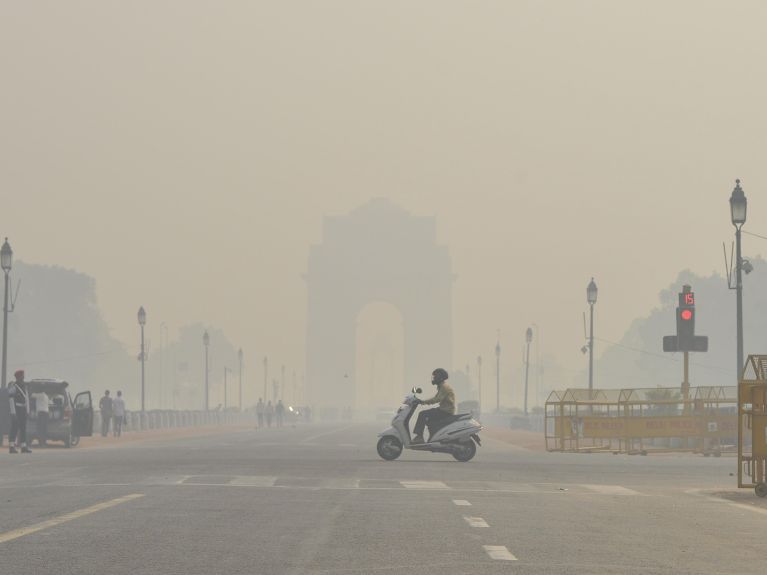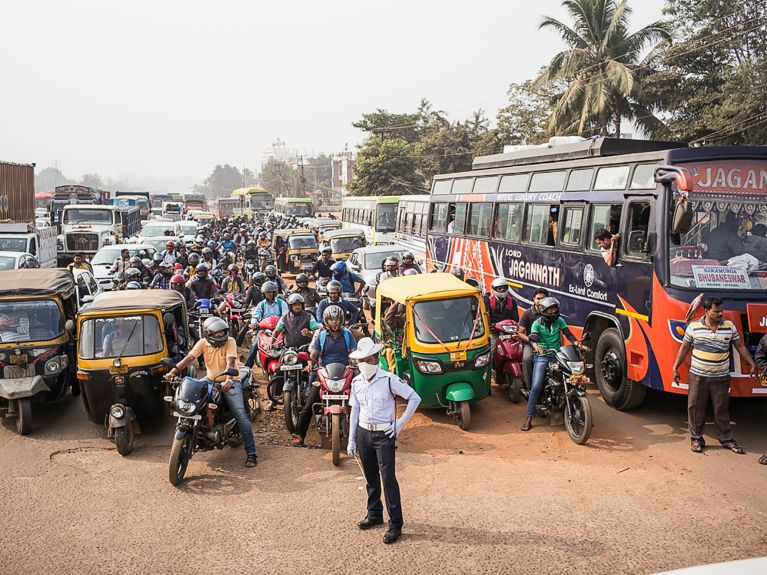Stop the smog!
Especially in winter, India suffers from smog. Germany is cooperating in providing low-emission mobility solutions.

A “Mo Bus” (which means “My Bus”) is one of those blue-white and green-and-white buses that have been driving through the East Indian state of Odisha since November 2018. The company advertises its reserved seats for women and seniors, free Wi-Fi and a mobile app that tracks live where the bus is and where the nearest stops are. Payment is cashless with a smart card, a rechargeable plastic card. That passenger numbers rose rapidly in the first year is in part thanks to the German Federal Ministry for Economic Cooperation and Development (BMZ).

In 2017, together with the Indian Ministry of Housing and Urban Development, the BMZ launched a project to develop integrated, sustainable transport systems for cities. Bhubaneswar, the capital of Odisha, is one of three cities where several projects have been started. The company CRUT, which operates modern city buses, also offers rental bicycles and e-rickshaws. All three modes of transport are paid for using the same smartcard; this is called an “integrated” system.
Roland Haas is an expert on the environment and traffic, and a project manager at the German Society for International Cooperation (GIZ), which the BMZ commissioned to carry out this project. Haas is proud of the success of the new mobility company CRUT. The number of passengers has increased from 15,000 per day to more than 100,000, he says. Recently, CRUT was named the best Indian bus company and the GIZ was given an award by the state of Odisha.
Haas and his colleagues aid the young company in planning routes and the use of buses and drivers. In September 2019 he visited Munich and Salzburg with managers of the Indian bus company. At two Munich transport companies they looked at how the efficient and heavily used traffic network of the Bavarian capital is managed. The group went to Salzburg, Austria, because of trolleybuses. These buses with electric motors, which draw their electricity from overhead lines as do trams, are a cheaper alternative to the underground, Haas explains.
In the other two Indian project cities, major roads are being redesigned with safe foot and bicycle lanes, express bus routes and elevated railways built, and electrically powered rickshaws introduced. Asked if he would like to highlight a particular project, Roland Haas shakes his head, laughing. “I like everything we do”, he says. The traffic and environment expert flies to India every two or three months to catch up on the progress of each project. Financing will continue until 2021; project leader Haas is optimistic that it will subsequently be renewed.

Merkel and Modi emphasize common goals
At the beginning of November, the German Chancellor Angela Merkel and the Indian Prime Minister Narendra Modi signed a joint declaration to promote green, low-emission mobility solutions in India. Merkel promised a low-interest loan of one billion euros. During her visit to the Indian capital of Delhi, the German Chancellor saw how urgent it is to make India's mobility greener. Delhi was covered in smog, and fine dust levels were, as often in winter, in the high health-threatening area. School children there are always given off when the smog is intense; many people suffer from chronic respiratory complaints. Experts say that one day of breathing in Delhi is as harmful as smoking 40 to 50 cigarettes in the same time. Those who can afford it, spend their days in rooms with air filter machines and leave the house only with breathing masks.
You would like to receive regular information about Germany? Subscribe here:


